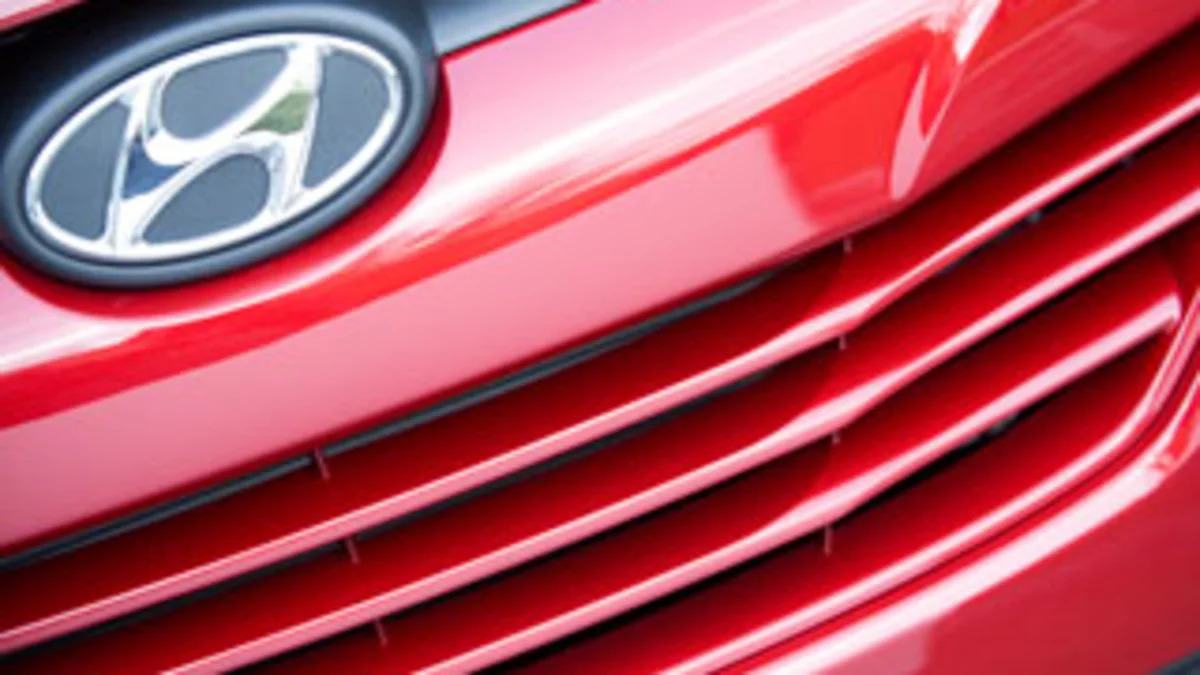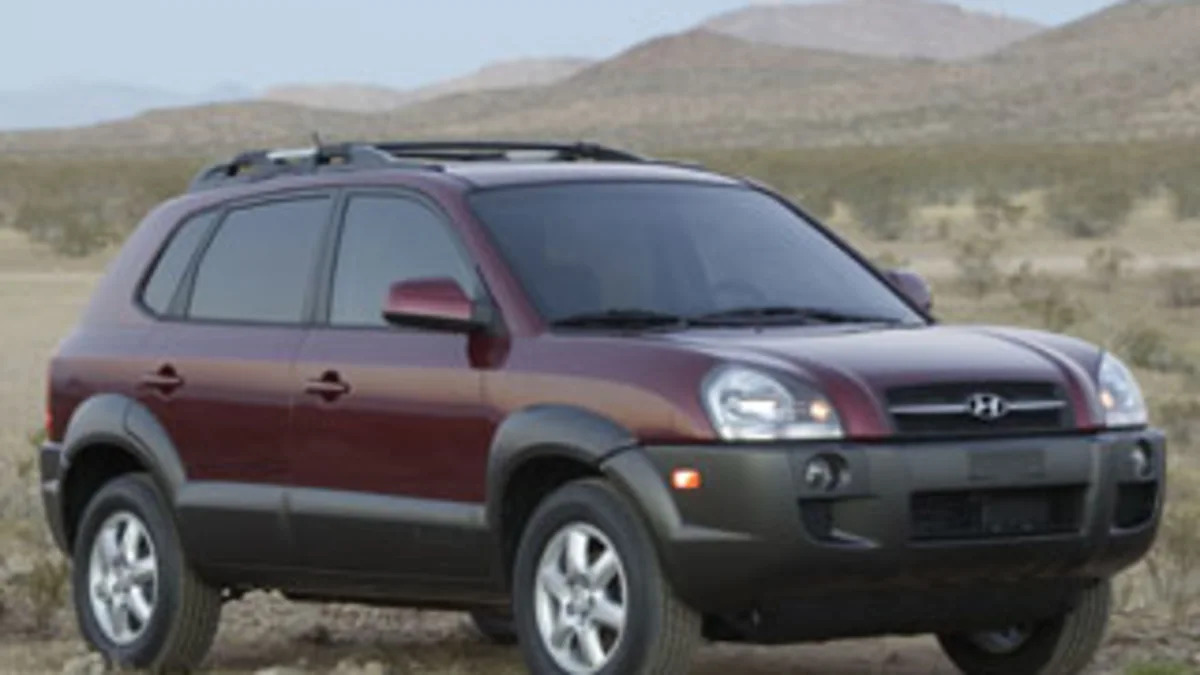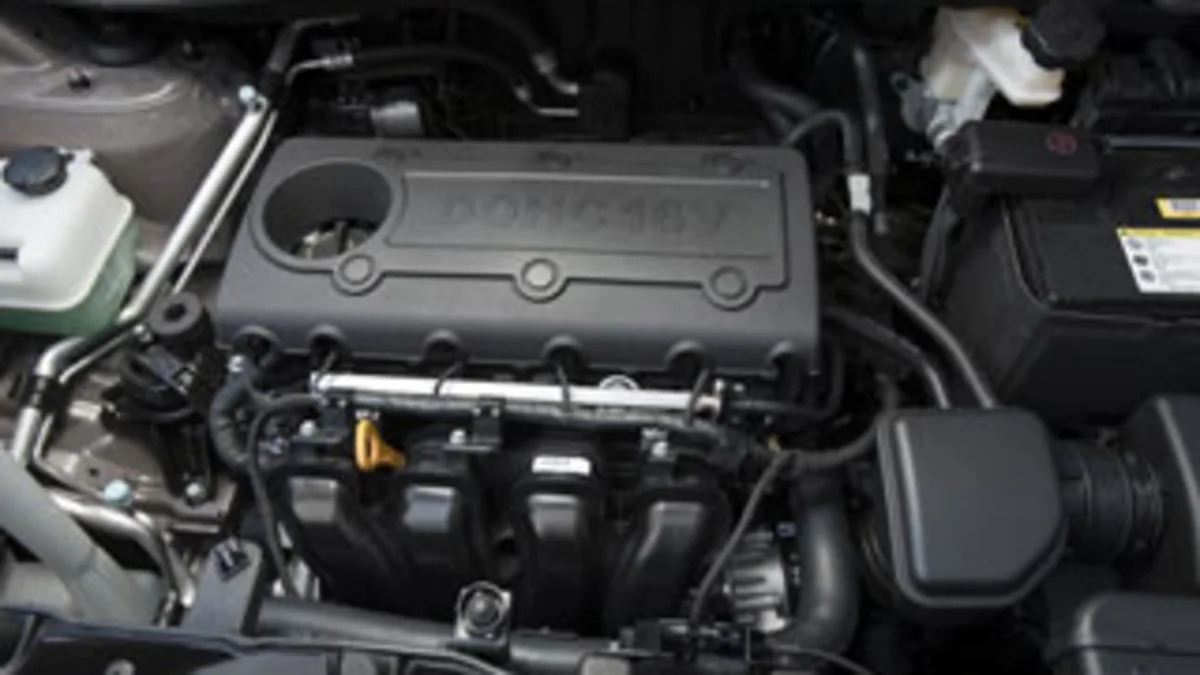Driven: 2010 Hyundai Tucson - Small Feels Big, Aggressive
Apr 2, 2010

-

- Image Credit: Hyundai
Back when the lords of the car industry cooked up the crossover (SUV looks with car-based guts), the idea seemed odd. But it worked: car-based SUVs offered the kind of drivability that most buyers wanted without all the heavy equipment needed in a "real" SUV. But, there was one problem: all the cars seemed to look alike.
The entire segment was awash in cars that looked like they wore loose-fitting jeans and comfortable shoes. Where coupes and bigger SUVs seem to still hold onto the spirit of the 90s (brash, Clintonian, perhaps unfortunately confident), the term "crossover" was generally used to describe something that looked like a throat lozenge. They were (and still are) defined by flowing lines, cute wheel arches, and an air of femininity that certainly did a proper job of selling the idea: Honda's CR-V, Ford's Escape and Toyota's RAV4 became hot sellers, still among the top 20 vehicles sold. The second-generation Chevy Equinox recently joined their ranks and all signs point to the crossover as being the thing that every automaker simply "has to have."- Research the Hyundai Tucson
- Hyundai Tucson Overview
- Hyundai Tucson Photos
- Free Hyundai Tucson Price Quote
-
- Image Credit: Hyundai
Hyundai's new Tucson makes a drastic departure from that styling, however. Its exterior is pulled taut -- no, not like a character from Real Housewives -- in a more muscular manner. Back a decade or so ago when this entire segment was pitched as the go-anywhere, do-anything vehicle for the urban warrior, auto shows promised us cars like this. Actually, car companies fed the public the idea of such a thing, but attempts like the Isuzu Vehicross never felt authentic. The cars that actually moved on the showroom floor were, in reality, a little too soft around the edges to appeal to the steeliest of male hearts.- Research the Hyundai Tucson
- Hyundai Tucson Overview
- Hyundai Tucson Photos
- Free Hyundai Tucson Price Quote
-
- Image Credit: Hyundai
We think that's why the new Tucson is so interesting. Part of what makes the new vehicle look so aggressive (the company calls it "Fluidic Sculpture" design) is the way they've brought the black plastic cladding up into the character line that starts on the lower part of the front door. You see how that line carries through to the rear of the vehicle? In doing do the entire car seems to point (or maybe even tilt) forward, more like a doorstop and less like a block of cheese. It's subtle but it helps.- Research the Hyundai Tucson
- Hyundai Tucson Overview
- Hyundai Tucson Photos
- Free Hyundai Tucson Price Quote
-
- Image Credit: Hyundai
Hyundai, in fact, hadn't really figured out how to create a small SUV with the previous generation of the Tucson. Originally launched in 2004, the Tucson was small and cute and relatively cheap, but it was also noisy. Reliability picked up (Consumer Reports called it one of the most reliable vehicles in 2009) but it wasn't an actual competitor to the CR-V, RAV4, Ford Escape or the (discontinued) Saturn Vue. It was, like many cars in Hyundai's lineup up until a few years ago, charming because of its price.- Research the Hyundai Tucson
- Hyundai Tucson Overview
- Hyundai Tucson Photos
- Free Hyundai Tucson Price Quote
-
- Image Credit: Hyundai
Hyundai's new strategy is not highly leveraged to price, although it's not a luxury car by any means. The new Tucson starts at $18,995, which is still thousands less than a Honda CR-V, Toyota RAV4, Chevy Equinox or Ford Escape. The price jumps when more options are loaded in, obviously, such that a high-priced Tucson can edge $30,000 when everything is added up. Of course, for the extra money you can get all-wheel-drive (otherwise the vehicle is front-wheel-drive), a navigation system, panoramic roof and rearview camera, the basics of suburban motoring these days.- Research the Hyundai Tucson
- Hyundai Tucson Overview
- Hyundai Tucson Photos
- Free Hyundai Tucson Price Quote
-
- Image Credit: Hyundai
One option you won't find is an engine bigger than a four-cylinder. As with the Sonata which we reported on a few weeks back, the Tucson is taking the bold step of shunning bigger engines. It's simple: you can have the four-cylinder engine and that's it. Why the dearth of offerings? The company doesn't feel people need it and the four-cylinder produces enough power (176 hp) to satisfy most buyers in this segment, who don't use their Tucsons for towing. Creating a car that's made only for four cylinders saves a lot of weight, too. Clearly, there's a fuel economy story here: the Tucson (which is mated to a 6-speed automatic transmission) gets over 31 mpg in front-wheel-drive trim. That's better than any of the main competitors, which don't crest into the 30s at all with similar equipment.- Research the Hyundai Tucson
- Hyundai Tucson Overview
- Hyundai Tucson Photos
- Free Hyundai Tucson Price Quote
-
- Image Credit: Hyundai
So, the car looks more aggressive, it's priced well and some nice options are available. Is that the end of the story? For some buyers, that might be all they need to hear. But, in actuality, there are some interesting parts about the Tucson's driving experience that are worth sharing. In four days of driving the Tucson in Los Angeles and San Diego, we found that the crossover had its charms from behind the wheel.
The first thing we noticed when we approached the Tucson was that the vehicle acted rather big from about 100-200 feet away, but appeared much smaller and manageable as we approached. Getting in and out wasn't difficult (rear seat access was particularly easy, we noted) and when finally behind the wheel the car seemed to flip-flop again: it then felt bigger and somehow, more secure, than other crossovers. The driver is situated a good ways from the front window, something that makes for better fuel economy (the low slope of the window cuts through the air a lot easier), but also gives passengers the feeling that they're safe inside. This is in contrast to a vehicle like the Ford Escape, which has a more upright front windshield. Rear visibility isn't great (the windows behind the rear doors are tiny and whatever they allow you to see is too high to be worthwhile), but that's the tradeoff for a vehicle that makes a strong design statement like this.- Research the Hyundai Tucson
- Hyundai Tucson Overview
- Hyundai Tucson Photos
- Free Hyundai Tucson Price Quote
-
- Image Credit: Hyundai
We did not want for power much, if at all, during our hour-long slogs in and out of LA traffic and through some more interesting back roads. The car's Theta II 2.4-liter engine spools up pretty fast (in fact, throttle response took a little while to get used to -- it had a hair trigger feel to it). The engine isn't the quietest, but the six-speed automatic goes some way toward keeping the noise down. It's frequently shifting up, giving you better fuel economy and a quieter ride. To compensate for the four-cylinder, the car has a good amount of noise suppression built in, blocking a lot of engine surge sounds from entering the cabin. In fact, at idle, it's difficult to know the car is even running.- Research the Hyundai Tucson
- Hyundai Tucson Overview
- Hyundai Tucson Photos
- Free Hyundai Tucson Price Quote
-
- Image Credit: Hyundai
Our main gripe about the driving experience was the steering. While the wheel itself followed the lead from other Hyundai products we love (a nice overall size, comfortable to the touch and fitted with all the radio and cruise controls we need), we felt the actual to- and fro- feedback on the wheel was artificial and sometimes a bit twitchy. While we'd like to tell you that we always keep our hands at 10 and 2, there are moments in any driver's life where you need to grab something from the seat, reach for a control on the center console or (gasp) pick up a cell phone. In these instances -- in low to medium speeds -- we found the Tucson's wheel too willing to turn quickly. We'd like Hyundai to calibrate that better -- or we'd like greater self-control to always have both hands on the wheel.- Research the Hyundai Tucson
- Hyundai Tucson Overview
- Hyundai Tucson Photos
- Free Hyundai Tucson Price Quote
-
- Image Credit: Hyundai
Hyundai's competition for this vehicle is significant. But now they finally have a vehicle that stands as a worthwhile rival to Toyota, Honda, Ford and Chevy on product alone (not just price). Our favorite vehicle in this segment up to date had been the Equinox, but it starts roughly $4,000 higher in price. Now there are two new crossovers we're recommending to friends, and the Tucson is one of them.- Research the Hyundai Tucson
- Hyundai Tucson Overview
- Hyundai Tucson Photos
- Free Hyundai Tucson Price Quote








